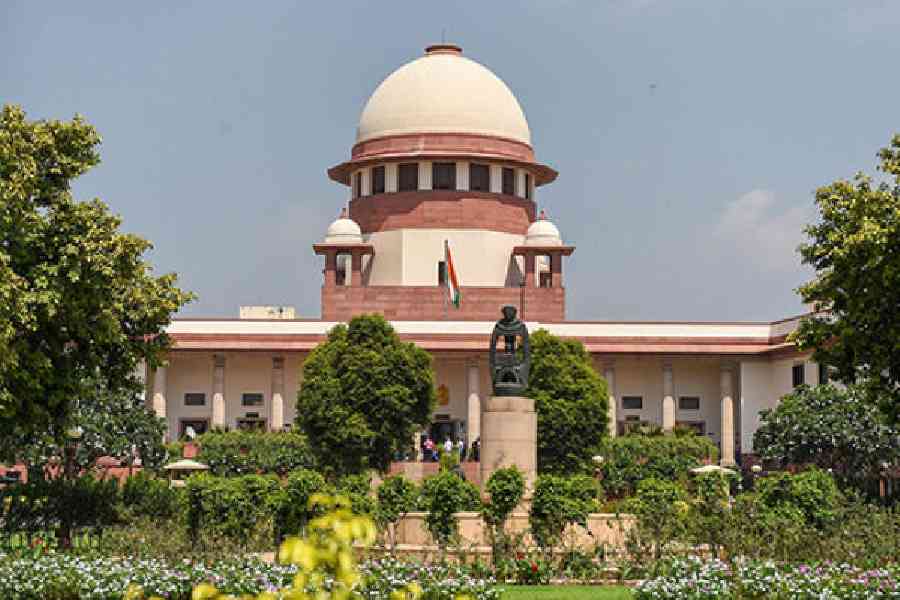The current regime’s vigorous efforts to reconstitute the Indian republic have at their foundation two separate, yet intersecting, phenomena: a majoritarian polity and an unequal economy. They may not be causally related to each other. They, however, are mutually facilitating. Together, they now wield enormous influence on the minds of a substantial section of vocal, educated, urbanised, middle and upper classes as well as professional sections of our society. Paradoxically, some among the poorer and lower middle classes and the socially disadvantaged sections too are under their spell.
In today’s India, the State machinery and its high functionaries openly wear Hindu majoritarian (different from religious) preferences on their sleeves. They speak in ways that normalise the ‘Othering’ of minorities. Leaders of the ruling dispensation now routinely refer to Muslims as infiltrators. That the functionaries of the State need to refrain from exhibiting their private religious preferences no longer remains an honoured canon in our public life. Earlier, fringe elements used to carry out the lynching of minorities, exhort the majority to stack weapons at homes, tell vigilantes to mark the houses of minorities, give calls for genocide against Muslims, declare an economic boycott of the community, felicitate those convicted for raping a pregnant Muslim woman and killing her unborn child and so on.
But now, such words and deeds have been mainstreamed. The Lok Sabha witnessed a ruling party member of Parliament deliver a hate speech against a Muslim fellow member. That MP was neither restrained by the Speaker nor reprimanded by his party. Today, the prime minister himself leads in hate speeches. Human Rights Watch found that during this year’s campaign for the general election, in the 173 rallies addressed by the prime minister, he made hateful remarks against Muslims in 110 of them. Recently, he told an election rally in Jharkhand that the minority community would snatch the daughters of the majority community if his party were not elected to power. The Uttar Pradesh government has normalised ‘bulldozer justice’ and routinely targets the Muslim minority. Hatred is trafficked now as virtuous patriotism.
The Union government is attempting to link citizenship to religion. The Citizenship (Amendment) Act and the National Register of Citizens are clearly a beginning in that direction. Once they are normalised, they could eventually be extended to the entire country. The religious fanfare at the opening of the new Parliament building and the prime minister’s dominant presence and participation in the inauguration of the Ram temple in Ayodhya are aggressive assertions of the dispensation’s Hindu majoritarian creed.
The political exclusion of the Muslim minority is now in plain sight. Even tokenism has been done away with. There is no presence of the biggest minority of this country in the Union cabinet. The ruling party does not have a single Muslim representative in Parliament. In states like Gujarat and Uttar Pradesh, where it has been in power for long, the Bharatiya Janata Party does not have a single MLA belonging to the principal minority community. In both states, Muslims have a salient presence in terms of population. There is no elected Muslim member in the lower Houses of those state legislatures either. In a final farewell to qualms, not a single Muslim was given ticket by the ruling party in those states. It is a mistake to suppose that the process of ‘Othering’ will stop with the Muslims. Once this is accomplished, majoritarianism will not rest. It will go after the remaining minorities. It’s one at a time.
Today, India is one of the most unequal countries in the world. World Inequality Lab reported that inequality in India has grown sharply since 2014 and is now at a historical high. Thomas Piketty’s research team found that the top 1% of the country’s population corners 22.6% of its income and owns 40% of its wealth. Oxfam’s 2023 report also came to similar conclusions. Its data show that the bottom 60% has only 3% of the nation’s wealth.
Rural wages and incomes are stagnant. While demand for luxury consumer brands is on the rise, for entry-level products, it has either been stagnant or in decline. Demand for work under the Mahatma Gandhi Rural Employment Guarantee Act is high and rising, marking a reverse migration from urban to rural areas. Unemployment is high at 8.8%. Retail inflation breached the Reserve Bank of India’s tolerance band and is currently at 6.21%. Consequently, the purchasing power of many has declined, leading to a sharp fall in household savings and a steep rise in household debt.
While we boast about being the fastest-growing and the fifth-largest economy in the world, the country is unable to rise above its 141st position out of 195 countries in the per capita income ranking. India ranks 105 out of 127 countries in the Global Hunger Index. Proud claims of lifting 250 million people out of poverty sit uneasily beside the necessity to give free rations to about 820 million. Rates of malnourishment and stunting and wasting among children remain shamefully high. An estimated 57% of Indian women between 15 and 49 years are anaemic.
While poverty and inequality push marginalised sections deeper into misery, key members of the dispensation’s economic establishment tell us ‘not to lose sleep over inequality’. When youth unemployment in the country is unacceptably high, they blame the ‘poverty of aspiration’, not lack of opportunities, for it. They see inequality and poverty as normal and hold the poor and the unemployed responsible for their poverty and joblessness.
In today’s India, it becomes easy for someone who tolerates the majoritarian polity to be tolerant of economic inequality. Conversely, it is easy for someone who tolerates economic inequality to be tolerant of majoritarian polity. From tolerance of these twin phenomena, it is easy to graduate to accepting them. From there on it is only a tiny step to becoming champions of a majoritarian polity and economic inequality. Our non-news media plays a decisive role in this ‘progression’ and in sewing these people’s eyes shut to the debilitating socio-economic inequalities.
They even argue that both these phenomena are, in fact, ideal. Glib and fast talkers among them argue on prime-time television that other paradigms for organising societies have failed. For them, ideal models existed in the past, dark ages. Some among them describe the majoritarian project as the recasting of India into a ‘civilisational state’. Some evangelists among them are at the forefront of providing intellectual justification for reconstituting our republic into a Hindu majoritarian one with red in tooth and claw neoliberal economic doctrine. Both these phenomena have inequality at their core: one condemns the poor to misery and the other disempowers minorities. Majoritarianism has one additional element: re-enthroning a new version of varnashrama dharma that reconstructs caste hierarchy within the Hindu fold with its own subtly layered ‘Othering’.
A large number of people do not share this soul-deadening, retrograde ideology. However, they are either unaware of or indifferent to the pernicious implications of these twin phenomena or are gaslighted into doubting the validity of modern India’s unique egalitarian and secular project. That this project is the logical extension of the cardinal principles of our freedom movement is now nearly forgotten. It is no surprise, therefore, that organisations that had no role in our freedom movement and did not share its egalitarian worldview are in the vanguard to destroy it.
Parakala Prabhakar is a political economist and the author of The Crooked Timber of New India











